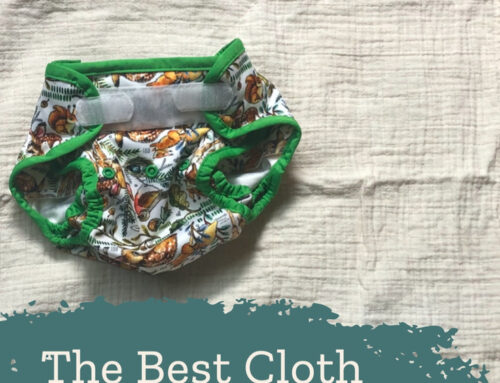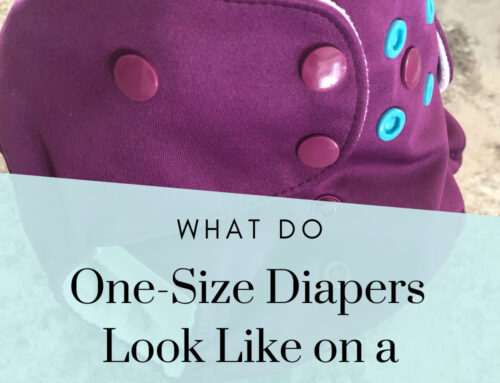For many first time parents, saving money with a baby is something that may be weighing heavily on their minds. According to the USDA, raising a baby costs $12,000 the first year of life, and $12,500+ for each year after that. That is a LOT of money, especially for young couples that may not be fully established in their careers yet. If that is you, just know that saving money with a baby is possible. It involves doing things differently sometimes, but it also means simplifying many things, too.
If you are both working parents and plan to send your child to daycare, expect that cost to go up significantly. Daycare costs vary a lot based on what type of care you choose and where you live. Care.com says the average cost for a daycare centers $211/week, and $580/week if you choose a nanny. That is per week, so you’re looking at around $850+ per month for a typical daycare center, and over $2300/month for a nanny on average.

We were stressed and not really sure what to expect. All we had ever heard was the kids are SO EXPENSIVE and that you needed to have a significant savings in order to adequately provide for them.
While having a significant amount of savings is great and I’ll never tell anyone they don’t need that (we all need to work toward that, kids or not!), you can definitely raise kids on a budget. Here are some ways that you can bring your sweet bundle of joy into the world without going broke.
Step 1: Make A Budget
Making a budget is important. Many people think they have a budget, but they make it too general and really don’t follow it very closely. Over the years, I have become a big proponent of the zero-based budget format promoted by Dave Ramsey.
To know where you can save money, you need to actually know how much you’re spending and exactly what you are spending it on. Take some time to go back through your online banking or credit card statements (however you normally purchase things) and do your best to categorize and tally up expenses.
It is incredibly eye-opening. It may not be perfect (for example, who really remembers what that Target purchase for $86 three weeks ago consisted of and how to split the money between groceries, toiletries, entertainment, clothing, etc.), but it will be incredibly helpful to know how much of your money is going to specific stores, how much you’re truly shopping online, how much you’ve spent on take out or restaurants, etc.
If you are here because you’re worried about your budget and fitting baby expenses into it, I can’t recommend the Total Money Makeover book by Dave Ramsey enough. This book has completely changed our lives and finances. I wish we had found it when I was pregnant, but it took us until my oldest was about a year and a half to truly get on board with this plan. Click here to get the Total Money Makeover or read customer reviews.
After you do your personal budget audit, you will be able to see exactly how much money you have to devote toward child expenses. That number may make you relieved, or it could terrify you. If it terrifies you, keep reading!
Step 2: Save, Save, Save
When you are pregnant, save as much money as possible! Even if it’s only $20/paycheck, it is worth it. Don’t tell yourself you don’t have enough money to save anything. Now is the time to really make some sacrifices for the greater good of your family.
Cut back on restaurants, clothing, anything not absolutely necessary. You need to build up savings to pay for your hospital expenses. The last thing you want to do when baby gets here is not only try to figure out how to pay for the expenses of day-to-day child raising, but also how to fit in a big hospital bill or monthly payments for that bill.
Depending on your financial situation and health insurance coverage, you may not be able to save the full amount, but anything is better than nothing.
If you’re having a hard time gaining traction with your savings or getting ahead on your budget, consider a part-time side gig before the baby comes. Companies like Shipt or Uber allow you to pick your own hours, so you can do it as much or as little as you want. You can earn tips and have greater financial flexibility.
I know it’s hard to commit to the idea of another job when you are planning for a little one, but if you/your partner do it now while you’re pregnant, you can quit or cut way back on it when the baby comes because you have made greater strides toward financial freedom.
Okay, so maybe you’re thinking, “I didn’t come here for a financial lecture, just give me some money-saving tips, please.” We will go into those now. I just needed to make sure I addressed having a budget and a savings first because you can do everything in the world to cut costs, but if you don’t truly have control of your money, you’re just trying to fill a pocket that has a hole in the bottom.
Without further ado, here are some ways to have a baby on a tight budget.
Use Cloth Diapers

Cloth diapers can save a significant amount of money, especially if you go for budget friendly cloth options. The greatest savings come in if you plan on having more than one child because cloth diapers can be used/re-used for years.
What’s funny is I got started on cloth diapers by searching for articles on this exact topic I’m writing about now. When I read the suggestion to use cloth diapers, my first thought was, “Umm…what?!? No way!” I didn’t realize people actually still did that, and I had no idea how far cloth diapers have come in the last decade. Modern cloth diapers are a lot different from what you may be thinking they are. I encourage you not to rule them out until you have at least looked into them.
Here are some resources to you acquainted with cloth diapers to see if they may be right for you:
Cloth Diapering 101 Series:
- Cloth Diapering 101- Introduction
- Cloth Diaper Types- Styles to Consider
- Cleaning Cloth Diapers – What Do I Do with the Poop?
- Cloth Diaper Washing Instructions
- Cloth Diaper Accessories
Cloth Diapers On A Budget:
Help with Making the Decision to Use Cloth:
- Cloth Diapering Vs. Disposables – A Look At The Facts
- Pros & Cons of Cloth Diapers
- Pros of Cloth Diapers
- How to Make Cloth Diapering Easier on Your Family
- Tips for Using Cloth Diapers
Cloth diapers may not be the budget answer you’re looking for, but they can certainly help. There are so many reasons to use cloth outside of saving money, too, so you have those as added perks.
My advice is to sit on the idea for awhile. Don’t immediately rule it out, but instead allow yourself time to see if it’s really something you would be up for. If you get a lot of push back from family and friends, check out this article: How to Deal with the Naysayers
Plan On Breastfeeding or Make Sure You’re Getting Deals on Formula
Breastfeeding can be a free food source for your baby. If you are able to do it, there are a ton of health benefits for both mom and baby.
Breastfeeding does have the potential to wrack up costs, so just keep that in mind. Between different nipple creams, nursing 
Check into your insurance company to see if they cover a breast pump, especially if you will be working outside the home. Most insurances will cover that, and it will help a lot.
If you are unable to breastfeed or don’t want to breast feed, there are ways to save money on formula. For me personally, I was able to breastfeed my babies from birth until 5 months for my oldest and 6 months for my youngest. Those were the times I returned to full-time work (I was lucky and had spring babies as a teacher, which means I got to combine summer in with my maternity leave).
At that time, I just could not produce enough with the pump. My youngest especially was having a hard time gaining weight, and I knew it was time to give it up. I tried to continue breastfeeding with just formula supplementation, but unfortunately, my body was not able to produce just a little bit of milk–I dried up completely. The bright side is at least weaning was easy, I guess!
Major formula manufacturers like Similac and Enfamil give out coupons to help lessen the burden of formula costs. Check out their websites to get signed up for their rewards. But don’t feel like you have to buy those big name brands to give your baby a quality formula–we personally used the Target brand (Up & Up) with both of our kids. It received a 5 start rating from the Clean Label Project.
Using the Target brand meant that we able to take advantage of Target’s baby promotions. They frequently have deals like, “Spend $50 on baby supplies and receive $10 gift card.” Those deals vary in amounts–could be spend $75 and get a $15 gift card, or spend $100 and get a $20 gift card, etc. I always took advantage of those with formula and would stock up.
Up & Up baby formula would also be on Cartwheel (Target’s coupon app) sometimes, so I was able to save even a little more, plus use my REDCard to save another 5{9994046f29331ee04cc0b5e07eb28364315ea03ccc2f01b5a43e8b85b372d1e9} at the end of the transaction.
Some people use these to stock up on disposable diapers, too, if you just really don’t want to go the cloth route. Just make sure you don’t buy too much of any one size, or you will have a bunch of diapers that your baby may grow out of before you realize it. Lots of babies don’t really grow linearly… they often have big growth spurts and before you know it, they need a new diaper size or bigger clothes. You don’t want to be stuck with 300 diapers in a size 2 when your baby is now ready for size 3!
If you have a Target near you, I really recommend having a REDcard. Saving 5{9994046f29331ee04cc0b5e07eb28364315ea03ccc2f01b5a43e8b85b372d1e9} might not seem like much, but if you go there often enough and spend $100 each time, why would you not want to knock off an easy $5 in savings? They have such a great baby section that the extra 5{9994046f29331ee04cc0b5e07eb28364315ea03ccc2f01b5a43e8b85b372d1e9} might come in handy more than just a few times.
There is a debit card option and a credit card option. We personally use the debit card option (we follow Dave Ramsey’s advice in Total Money Makeover), but if you are comfortable with credit cards, either option works great. Click here to apply for a Target REDcard.
Buy Baby Clothes Used

You can also check local thrift stores to see what is available. I’ve personally always found the best deals online in Facebook Marketplace or B/S/T groups, but it doesn’t hurt to look. Once Upon A Child is a popular chain, but stores like Salvation Army or Goodwill also have baby clothes. Do a search online to see what is available in your area for thrift stores.
You can also look for consignment sales. This will vary depending on your town or city. I have not come across a consignment sale in my town, but a town about 15 minutes away has them frequently. An internet search is the best way to check what you have in your area.
Say No to Frivolous Purchases
This may be the most important thing when it comes to saving money on baby expenses.
What do babies need?
- Food
- Diapers
- Clothes
- A safe sleeping space
- Basic toiletries (like baby soap and diaper cream)
- A car seat
- Love
That’s about it. You don’t NEED three different baby wraps, even though collecting baby carriers is the trendy thing to do right now. You don’t NEED a fancy jogging stroller. You don’t need a high-tech video baby monitor, a cute or trendy diaper bag, or a bunch of adorable photo props.
That doesn’t mean any of the above things are useless at all. I love my stroller and I loved my video monitor while it lasted (my youngest dipped the monitor in a glass of water about six months ago, so now we are monitor-less). But these are not things you need to feel pressured to buy before the baby comes.
Maybe you will get lucky and have a baby shower in which you are gifted many of these fun items. But if not, don’t feel like you have to go out and buy them yourself, at least not right away.
Buy your NEEDS before the baby comes, and then wait on other items until you are settled in with your baby and have a better idea of what will really benefit your lifestyle vs. what will sit around unused. Then fit those items into your budget as necessary.
Avoid the temptation to buy expensive items for your baby and think you’ll just sell them when you’re done. While it may work out for you, the baby market is changing all the time. I bought a Mamaroo swing for my youngest baby because we didn’t have a swing for my oldest, and I was convinced a swing would have made our sleeping issues better.
Well, not only did the Mamaroo not make my baby sleep better, he didn’t really like it at all. Then when I listed it for sale, my local market was saturated with them and I had no takers. The same thing happened with my Tula carrier.
Do not count on being able to sell something to earn that money back. It may work out for you, but it may not. Only buy items that you would still want to spend your hard-earned money on even if you couldn’t sell it in the end.
What Drives Up the Cost of Babies?
If you do the above things, you will find that (outside of daycare expenses), your baby expenses will slide right in with your other monthly expenses and not be a dramatic hit to your wallet. Your expenses will no doubt go up a bit, but you will be prepared for them. You may even be able to offset them with other lifestyle changes.
In my experience, I have found the cost of children goes up quite a bit the older they get. It’s not the baby expenses that do you in (unless you’re spending a lot on diapers, formula, clothes, every miscellaneous baby item, etc.), but as your kids get older and want to do different activities like swimming lessons or soccer camps and start eating all the food you buy at the grocery store in one day… then they really start to hurt your wallet more.
You can prepare for that by following my first two steps above–making a budget and building a savings. Getting on the right path with money will save you so much stress down the line.
Do you have any tips to add for saving money on raising kids? Let me know in the comments!






This is really good article to read today for me. I never knew that raising a baby can cost $12000 a year and $12500 + after that. That is just crazy money and as it is said in the article for a young couple it may be really hard to cope up with that.
Well no worries for them if they read this article because this article has a lot of tips to overcome that .
Thank you so much for sharing this article with us.
Thank you so much!
Hello Holy Lee, you have great insights in the article, many thanks. I am a young father of two, and I can attest that raising the kids has been quite draining to the bank account hither to; it’s no joke at all. My wife and I are already using cloth diapers for our little daughter who is 6 months old now. You have pointed out some things we can do and we are going to implement and hopefully reduce on the cost of raising them.Best regards
Glad you found it helpful, Victor! Good luck to you.
I think the most important tip you covered here is your second step – making sure you save as much as possible when you are pregnant.
This was down to me when my partner was pregnant with our second child, and I took it very seriously. I actually ended up using a shoe box under the bed to leave spare notes in – it’s amazing how fast it all adds up if you just keep adding to it regularly!
That’s awesome, Chris. Great work!
Hi.
All your advice for saving money with a baby are good ones. In fact, I’ve had to learn most of this the hard way but I already follow most of the advice you give. The hardest part for us was having to readjust our finances after losing my income in the monthly budget. For some reason, we just didn’t change how we were spending money until we couldn’t pay rent. At that time my baby was 4 months old. That was an incredibly stressful time!
I’m a bit surprised if you can find daycare for under $1,000 a month. The cheapest one we found around here in the NW was closer to $1,200 per month. Either way, it’s really expensive.
When I was working full time with kids in daycare, our daycare bill was 1.5x our mortgage! It’s crazy. It was by far our biggest monthly expense, and we went with a “cheap” daycare, too.
Im 51 now and my Father is long passed. He, however told me something many years ago when my wife and I were thinking of having a family. I told him I didnt think we could afford kids. His answer was that if you wait until you can afford them you will never have them.
Of course a plan in place is great but Im also here to tell you that where there is a will there is a way. As a parent you will do what ever it takes to make sure they have everything they need.
This is a great advice article and anyone reading it really needs to pay attention because the more you can get accomplished before baby is born the better.
Dale
Thanks, Dale! You are absolutely right–things definitely have a way of working out, and if you’re willing to make sacrifices and do some planning, you can definitely make it work.
Let me start by saying that I didn’t know that cloth diapers are back. I know they were used long time ago, but I didn’t know that they still make them.
Another thing that I never thought of is the breastfeeding being costly. I never thought of creams and breast pumps. Anyway, I really like the advice you gave about budgeting because many people are just having babies without planning and budgeting. You also gave very helpful money-saving tips. Great post and very interesting to read.
Thanks Rose! Yes, breastfeeding on the surface starts out as free, but it can be easy to get carried away with all the accessories there are available to make it easier. Especially if you have some issues with it (like I and many others did/do), it can add up quickly to try and purchase things that will fix the problem.
Thanks for your comment!